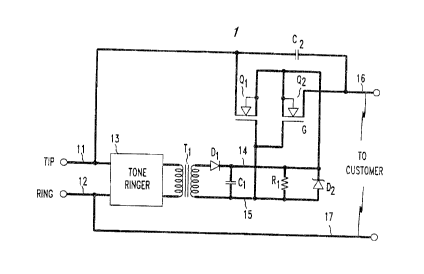Some of the information on this Web page has been provided by external sources. The Government of Canada is not responsible for the accuracy, reliability or currency of the information supplied by external sources. Users wishing to rely upon this information should consult directly with the source of the information. Content provided by external sources is not subject to official languages, privacy and accessibility requirements.
Any discrepancies in the text and image of the Claims and Abstract are due to differing posting times. Text of the Claims and Abstract are posted:
| (12) Patent: | (11) CA 2077992 |
|---|---|
| (54) English Title: | MAINTENANCE TERMINATION UNIT FOR ISDN |
| (54) French Title: | UNITE TERMINALE POUR RNIS |
| Status: | Deemed expired |
| (51) International Patent Classification (IPC): |
|
|---|---|
| (72) Inventors : |
|
| (73) Owners : |
|
| (71) Applicants : | |
| (74) Agent: | KIRBY EADES GALE BAKER |
| (74) Associate agent: | |
| (45) Issued: | 1998-04-21 |
| (22) Filed Date: | 1992-09-10 |
| (41) Open to Public Inspection: | 1993-04-05 |
| Examination requested: | 1992-09-10 |
| Availability of licence: | N/A |
| (25) Language of filing: | English |
| Patent Cooperation Treaty (PCT): | No |
|---|
| (30) Application Priority Data: | ||||||
|---|---|---|---|---|---|---|
|
Disclosed is a Maintenance Termination Unit (MTU) for an Integrated
Services Digital Network (ISDN). A tone ringer is provided at the end of the
customer loop to generate an AC signal. The signal is applied through a transformer
and rectifier to charge a capacitor. The resulting voltage across the capacitor causes
a normally closed MOS switch to open and disconnect the customer until the
capacitor discharges.
On présente ici une Unité de terminaison de maintenance (MTU) pour un réseau à intégration de services numériques (RNIS). Une sonnerie électronique est installée à l'extrémité de la boucle du client pour générer un signal CA. Ce signal est appliqué au travers d'un transformateur et d'un redresseur à un condensateur pour le charger. La tension résultante aux bornes du condensateur provoque l'ouverture d'un interrupteur MOS normalement ouvert et déconnecte le client pendant toute la durée de décharge du condensateur.
Note: Claims are shown in the official language in which they were submitted.
Note: Descriptions are shown in the official language in which they were submitted.

For a clearer understanding of the status of the application/patent presented on this page, the site Disclaimer , as well as the definitions for Patent , Administrative Status , Maintenance Fee and Payment History should be consulted.
| Title | Date |
|---|---|
| Forecasted Issue Date | 1998-04-21 |
| (22) Filed | 1992-09-10 |
| Examination Requested | 1992-09-10 |
| (41) Open to Public Inspection | 1993-04-05 |
| (45) Issued | 1998-04-21 |
| Deemed Expired | 2010-09-10 |
There is no abandonment history.
| Fee Type | Anniversary Year | Due Date | Amount Paid | Paid Date |
|---|---|---|---|---|
| Application Fee | $0.00 | 1992-09-10 | ||
| Registration of a document - section 124 | $0.00 | 1993-04-02 | ||
| Maintenance Fee - Application - New Act | 2 | 1994-09-12 | $100.00 | 1994-07-19 |
| Maintenance Fee - Application - New Act | 3 | 1995-09-11 | $100.00 | 1995-07-27 |
| Maintenance Fee - Application - New Act | 4 | 1996-09-10 | $100.00 | 1996-07-16 |
| Maintenance Fee - Application - New Act | 5 | 1997-09-10 | $150.00 | 1997-07-21 |
| Final Fee | $300.00 | 1997-12-22 | ||
| Maintenance Fee - Patent - New Act | 6 | 1998-09-10 | $150.00 | 1998-06-22 |
| Maintenance Fee - Patent - New Act | 7 | 1999-09-10 | $150.00 | 1999-06-19 |
| Maintenance Fee - Patent - New Act | 8 | 2000-09-11 | $150.00 | 2000-06-19 |
| Maintenance Fee - Patent - New Act | 9 | 2001-09-10 | $350.00 | 2002-09-06 |
| Maintenance Fee - Patent - New Act | 10 | 2002-09-10 | $200.00 | 2002-09-06 |
| Maintenance Fee - Patent - New Act | 11 | 2003-09-10 | $200.00 | 2003-08-21 |
| Maintenance Fee - Patent - New Act | 12 | 2004-09-10 | $250.00 | 2004-08-19 |
| Maintenance Fee - Patent - New Act | 13 | 2005-09-12 | $250.00 | 2005-08-05 |
| Maintenance Fee - Patent - New Act | 14 | 2006-09-11 | $250.00 | 2006-08-08 |
| Maintenance Fee - Patent - New Act | 15 | 2007-09-10 | $450.00 | 2007-08-08 |
| Maintenance Fee - Patent - New Act | 16 | 2008-09-10 | $450.00 | 2008-08-11 |
Note: Records showing the ownership history in alphabetical order.
| Current Owners on Record |
|---|
| AMERICAN TELEPHONE AND TELEGRAPH COMPANY |
| Past Owners on Record |
|---|
| DEBALKO, GEORGE ANDREW |